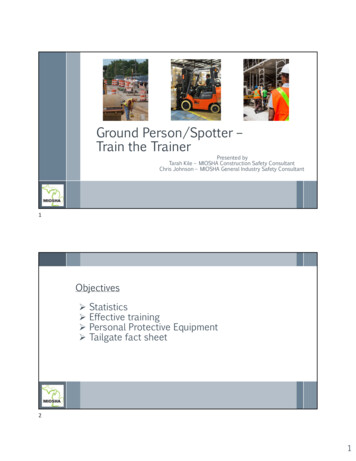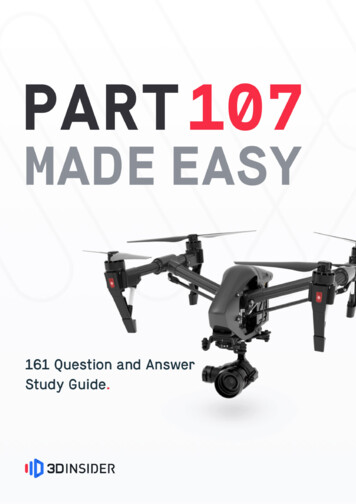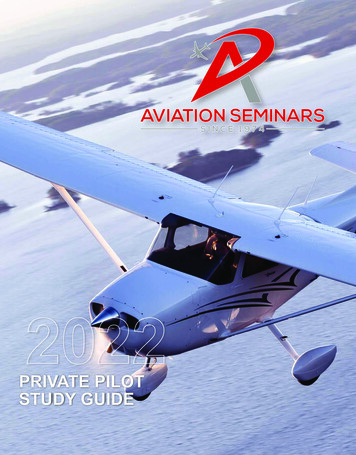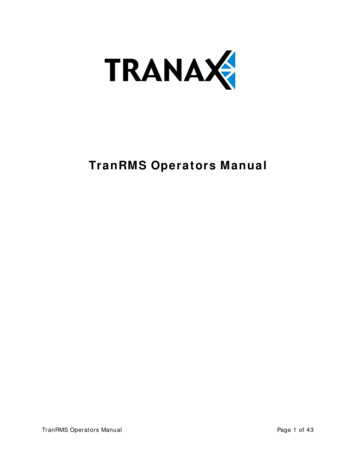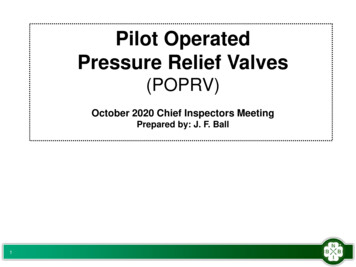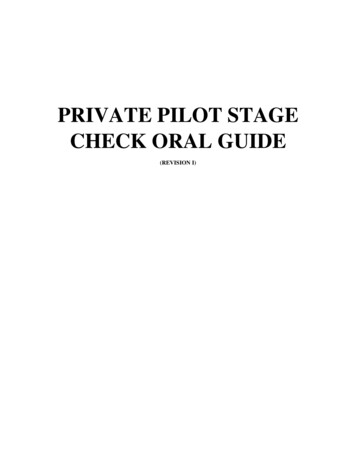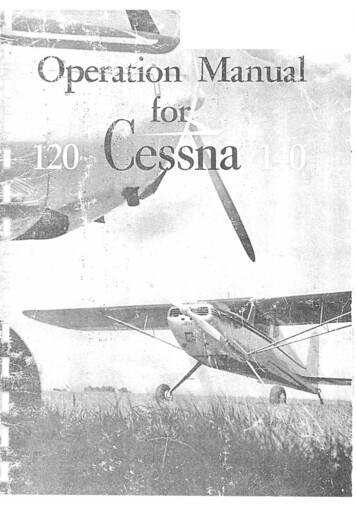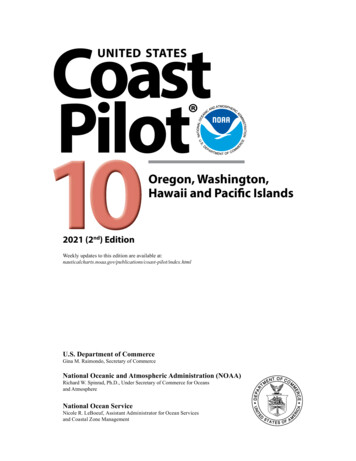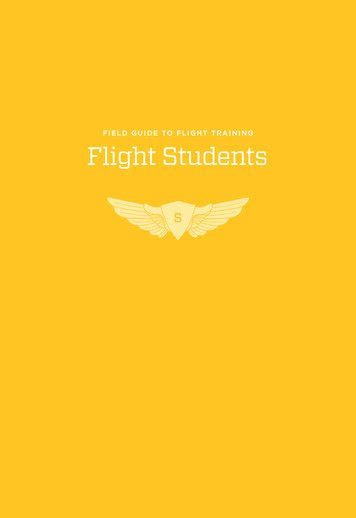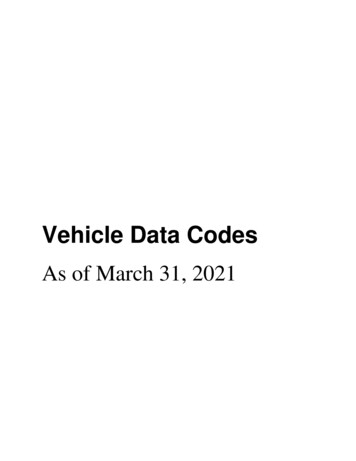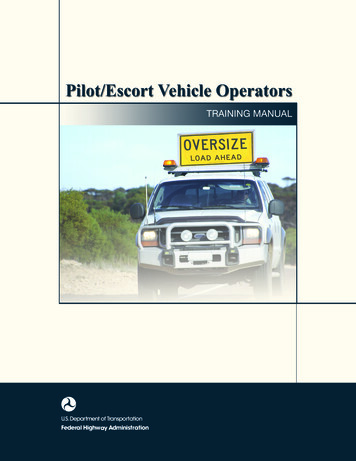
Transcription
Pilot/Escort Vehicle OperatorsTRAINING MANUAL
TRAINING MANUAL Pilot/Escort Vehicle OperatorsNoticeThis document is disseminated under the sponsorship of the U.S. Department ofTransportation in the interest of information exchange. The U.S. Governmentassumes no liability for the use of the information contained in this document.This report does not constitute a standard, specification, or regulation. TheU.S. Government does not endorse products of manufacturers. Trademarks ormanufacturers’ names appear in this report only because they are consideredessential to the objective of the document.Quality Assurance StatementThe Federal Highway Administration (FHWA) provides high quality informationto serve Government, industry, and the public in a manner that promotes publicunderstanding. Standards and policies are used to ensure and maximize the quality,objectivity, utility, and integrity of its information. The FHWA periodically reviewsquality issues and adjusts its programs and processes to ensure continuous qualityimprovement.Cover image: iStock.com/olaser
Pilot/Escort Vehicle Operators TRAINING MANUALTechnical Report Documentation Page1. Report No.2. Government AccessionFHWA-HOP-16-050No.4. Title and SubtitlePilot/Escort Vehicle Operators Training Manual3. Recipient’s Catalog No.7. AuthorsAnn Hamilton PhD8. Performing OrganizationReport No.9. Performing Organization Name and Address10. Work Unit No. (TRAIS)Leidos11251 Roger Bacon DriveReston, VA 2019012. Sponsoring Agency Name and AddressU.S. Department of TransportationFederal Highway Administration1200 New Jersey Avenue, SEWashington, DC 205905. Report DateFebruary 20176. Performing Organizations Code11. Contract or Grant No.Contract No.13. Type of Report and PeriodCoveredTraining HandbookSeptember 2014 – December201614. Sponsoring Agency CodeHOFM15. Supplementary NotesJohn Berg, FHWA16. AbstractThis student training manual is the companion document for the Pilot/Escort Vehicle Operator(P/EVO) Training Course. The manual is designed to prepare individuals to fulfill pilot/escort dutiessafely and effectively. It includes an overview of the pilot/escort industry, requirements forP/EVOs and their vehicles, procedures for escorting oversize loads, elements of route planning,issues of driver safety, and many important related topics. It further promotes and facilitatesunderstanding of the regulations, duties, and responsibilities of P/EVOs and provides practicalinformation on such issues as safe maneuvering and vehicle positioning, typically requiredequipment and its uses, and examples of the substantial variance in rules governing P/EVOs fromState to State.17. Key Words18. Distribution StatementPilot/Escort Vehicle Operators, Pilot Escort Vehicle Equipment,No restrictions.Pilot Escort Vehicle Route Planning, Route Survey, Pilot EscortVehicle Pre-Trip Planning, Pilot Escort Vehicle Trip Operations,Oversize Loads, Pilot Escort Vehicle Driver Safety, P/EVOTraining, Pilot Cars19. Security Classif. (of this report) 20. Security Classif. (of this 21. No of Pages 22. PriceUnclassifiedpage) Unclassified140N/AForm DOT F 1700.7 (8-72)Reproduction of completed page authorized.
Pilot/Escort Vehicle Operators TRAINING MANUALTable of ContentsMODULE 1: COURSE INTRODUCTION AND INDUSTRY BACKGROUND. 1LESSON 1: INTRODUCTION.1LESSON 2: PILOT ESCORT INDUSTRY BACKGROUND.2Pilot/Escort Vehicle Operator Industry Safety Efforts.2Industry Evolution and the Lack of Uniformity.4Deaths in Large Truck Crashes .5Regulation of Trucks and Drivers.5Role of Pilot/Escort Vehicle Operators.6Reasons for Pilot/Escort Vehicle Operator Certification .7Professionalism in the Industry.7LESSON 3: COURSE AND TRAINING MANUAL STRUCTURE.8The Certification Examination.9MODULE 2: PILOT ESCORT OPERATOR AND VEHICLE EQUIPMENTREQUIREMENTS.11LESSON 1: PILOT ESCORT OPERATOR REQUIREMENTS.12Pilot/Escort Vehicle Operator Certification and Reciprocity among States.12LESSON 2: ESCORT VEHICLE EQUIPMENT REQUIREMENTS.14Looking Ahead.15Benefits of CBs over Cell Phones.20MODULE 3: ROUTE PLANNING. 23LESSON 1: ROUTE SELECTION AND REVIEW.23LESSON 2: ROUTE SURVEY.24Route Survey Tools.24Route Survey Procedures.25Route Survey Contents.26Railroad Crossings.28Route Survey Evaluation.30MODULE 4: PRE-TRIP ACTIVITIES. 31LESSON 1: PRE-TRIP PLANNING AND PROCEDURES. 31Assignment Confirmation. 31LESSON 2: PRE-TRIP SAFETY MEETING.35Communication Issues.35Establishing Team Dynamics.36Load Issues.37Hazardous Materials .37Permit and Route Review.38When Pre-Trip Activities Are Not Possible: The Modified Pre-Trip Meeting .40iii
TRAINING MANUAL Pilot/Escort Vehicle OperatorsLESSON 3: VEHICLE INSPECTIONS.42Pre-Trip Inspections and Opportunity Inspections.42MODULE 5: TRIP OPERATIONS. 49Characteristics of Oversize Loads .49Parking and Backing Issues.50Stopping Distances.51LESSON 1: LOAD MOVEMENT—THE ROLE OF PILOT/ESCORT VEHICLE OPERATORS. 52Permits.52Load Movement Preparation.53Inspection and Monitoring During Load Movement.53Pilot/Escort Vehicle Operators Responsibilities.54Role of the Lead Pilot/Escort Vehicle Operator.55Seeing Hazards.55Role of Rear Pilot/Escort Vehicle Operator.58Load-related Hazards.59LESSON 2: EQUIPMENT DEPLOYMENT AND OPERATION.65Flagging Equipment.65Emergency Equipment.66Pilot/Escort Vehicle Operator Special Skills.67LESSON 3: ROADWAY POSITIONS AND PROCEDURES.69Pilot/Escort Vehicle Operator Positions.70LESSON 4: TRAFFIC CONTROL OPERATIONS.72Equipment for Controlling Traffic.75Traffic Control Authority.77LESSON 5: RAILROAD CROSSINGS.77Oversize Load Issues.79Route Survey Issues.80Types of Crossings.80Procedures for Negotiating Railroad Crossings.80Railroad Crossing Safety Reminders.82LESSON 6: EMERGENCY PROCEDURES.84Traffic Emergencies.85Vehicle Emergencies.87Emergency Roadside Parking/Breakdowns.89MODULE 6: POST-TRIP RESPONSIBILITIES AND ACTIVITIES. 93LESSON 1: AFTER THE TRIP – VEHICLE AND EQUIPMENT TASKS.93Warning Lights.94Oversize Load Signs and Flags.94Height Pole.94Data for Trip Log.94iv
Pilot/Escort Vehicle Operators TRAINING MANUALLESSON 2: POST-TRIP EVALUATION.95Assignment Evaluation.95Route Survey Evaluation.96Communication Equipment and Procedures Evaluation.97Emergency Response Evaluation.97LESSON 3: WRITTEN REPORTS AND TRIP LOGS.98MODULE 7: DRIVER SAFETY ISSUES. 99LESSON 1: DISTRACTIONS.99LESSON 2: DROWSY DRIVING (FATIGUE) .102Hours of Service Rules.103Dangers of Drowsy Driving/Fatigue.103Recognizing Danger Signs of Drowsiness and Fatigue.104Fatigue and Vision.106Preventing Drowsy Driving.106LESSON 3: AGGRESSION.108What Can a Pilot/Escort Vehicle Operator Do To Minimize Aggressive Behavior?.108What Can a Pilot/Escort Vehicle Operator Do If Confronted by an Aggressive Driver?.109LESSON 4: GENERAL SAFE DRIVING PRACTICES . 110Driving in Adverse Conditions. 110Managing Speed and Space. 114Braking Tips. 116Managing Space. 118LESSON 5: SAFETY TECHNOLOGIES.120Other Safety Technologies and Strategies.122MODULE 8: COURSE EXAM AND EVALUATION. 125GLOSSARY. 127ADDITIONAL RESOURCES. 127v
Pilot/Escort Vehicle Operators TRAINING MANUALList of TablesTable 1. Sample of State rules for traffic control/flagging. 73Table 2. Hierarchy of traffic control personnel. 73Table 3. Total highway-rail incidents for all States, January to May, 2010 to 2015. 78List of FiguresFigure 1. Photo. Manual on Uniform Traffic Control Devices (MUTCD) work zone warningroad sign . 57Figure 2. Photo. Maryland road sign. 57Figure 3. Photo. Inadequate under-ride guards contribute to deaths and injuries in rear-impactcrashes, as shown here. 122Figure 4. Photo. Stronger under-ride guards, as shown in this photo, reduce deaths and injuries inrear-impact crashes. 122vii
Pilot/Escort Vehicle Operators TRAINING MANUALMODULEMODULE1Course Introduction and Industry BackgroundLESSON 1: INTRODUCTIONWelcome to the pilot/escort vehicle operator (P/EVO) training course. This courseis designed to prepare individuals to fulfill pilot/escort duties safely and effectively.It includes an overview of the pilot/escort industry, requirements for P/EVOs andtheir vehicles, procedures for escorting oversize loads, elements of route planning,issues of driver safety, and many important related topics.The course promotes and facilitates understanding of the regulations, duties, andresponsibilities of P/EVOs and provides practical information on such issues assafe maneuvering and vehicle positioning, typically required equipment and itsuses, and examples of the substantial variance in rules governing P/EVOs fromState to State.The course also includes a large number of sources of information about State rulesand regulations, best practices, guideline documents, and other relevant sourcematerials. These sources are important for three reasons:1. Learning how to be a P/EVO is similar to most other professions: individualslearn how to do the job primarily by doing it, but they must start with a basicunderstanding of the job. This is a primary purpose for certification courses:to learn the laws and rules that apply to pilot/escort vehicle operation in thecertifying State. Once certified, P/EVOs are responsible for knowing therelevant laws and rules in all the States in which the P/EVOs will escort oversizeloads.2. While it is not possible to learn everything about being a P/EVO in a oneday course, it is possible to gain adequate knowledge about the sources ofinformation needed to operate lawfully and safely from State to State.3. These sources—and how to locate and use the information—enable the P/EVOto keep up-to-date with changes in the rules over time, which is one of the mostonerous tasks the P/EVO must accomplish.There are very few Federal rules that govern escort operations, so as a matter ofpublic safety, P/EVO regulations are established by each individual State, andStates have substantially different approaches to the permitting and regulationof oversize load movement. Variations exist among States in defining situations1
TRAINING MANUAL Pilot/Escort Vehicle Operatorsin which escorts are required, determining how many escorts are required undercertain conditions, and establishing the types of equipment and signs the P/EVOmust have, among many others. It is the responsibility of the P/EVO to know thelaws of each State through which the escorted load moves, just as it is for driverswith a commercial driver’s license (CDL) or a basic driver’s license.LESSON 2: PILOT ESCORT INDUSTRY BACKGROUNDAcross the United States, Canada, and Mexico, and in many other countries,P/EVOs are required for the movement of oversize loads, and for all thedifferences among the States in the regulation of these loads, the purposes forP/EVOs are substantially consistent from place to place. P/EVOs are in placeto enhance the safety of roadway users, to protect transportation infrastructure,the load driver, the load, as well as the P/EVOs themselves and law enforcementescorts when required.The number of permits issued for oversize loads increases every year. It is apparentthat more P/EVOs, including those with specialized skills such as height poleoperation, will be needed for the foreseeable future.Pilot/Escort Vehicle Operator Industry Safety EffortsThe P/EVO industry has difficulties similar to other transportation-related entitiesin terms of safety programs, such as a lack of funding to support education andenforcement efforts; a lack of coordination among groups, both public and private,that would benefit from working together; and a lack of standards in even the mostbasic operational processes and equipment requirements. Efforts at better State toState harmonization are being made by organizations including, among others: Federal Highway Administration (FHWA). American Association of State Highway and Transportation Officials andregional subsidiary groups: Western Association of State Highway andTransportation Officials, Northeast Association of State TransportationOfficials, Southeastern Association of State Transportation Officials, MidAmerica Association of State Transportation Officials. Specialized Carriers & Rigging Association (SC&RA). Commercial Vehicle Safety Alliance (CVSA). Owner Operator Independent Drivers Association (OOIDA). Insurance industry representatives.Standardizing the safety equipment requirements for P/EVOs and/or insuranceand certification requirements, for example, would benefit highway users, States,P/EVOs, and carriers. One example of a current standardization effort is thevoluntary adoption by many States of the temporary traffic control requirementsfor flagging and equipment found in the Manual for Uniform Traffic Control2
Pilot/Escort Vehicle Operators TRAINING MANUALDevices.1 As a matter of safety, it is important that P/EVOs performing trafficcontrol procedures have similar appearance and use the same equipment andmethods regardless of where they may be controlling traffic. With the exceptionof driving in front of a very large heavy load (a load that cannot maneuver orstop quickly), flagging traffic is perhaps the most dangerous activity a P/EVO isrequired to perform. It is appropriate, therefore, that traffic control procedures andequipment be standardized in order for highway users to know and understandthose procedures.An important example of an area related to oversize load movement that needsto be better standardized is railroad crossings. Similar to P/EVO operations andrequirements, railroad-highway crossings and the rules and standards applyingto them vary from State to State. Better coordination among railroad companies,highway designers, maintenance personnel, and others could bring about jointwarning signal inspections, integrated track and highway maintenance processes,and—highly relevant for P/EVOs and oversize/overweight load drivers andcarriers—designating problematic crossings for special permit vehicles. Inaddition, coordination in setting standards, designing crossings, and reportingemergencies would benefit not only highway users and taxpayers but also therailroads and the States, carriers, load drivers, and P/EVOs.2A general lack of information about the escort industry is a further impedimentto developing and managing standards and, therefore, to harmonizing P/EVOrequirements among the States. P/EVO duties and responsibilities, requiredequipment, insurance requirements, and other rules differ widely from State toState. No formal national certification process exists in the pilot/escort vehicleoperator industry, unlike commercial driver certification (i.e., CDL holders).3 CDLs(as well as basic operator’s licenses) are accepted in all States, in part becauseof the standardization of training and testing in these programs.4 The AmericanAssociation of Motor Vehicle Administrators has developed a model CDL trainingmanual that most States have adopted with a few adjustments to reflect specificState laws and rules.5 This training manual and related materials are designed toaddress this need to better standardize and enhance training for P/EVOs.Escorting oversize loads requires skill and awareness similar to that of emergencyvehicle operators, tow truck drivers, roadside mechanics, and others who performdangerous roadside operations. P/EVOs are frequently required, for example,to control traffic during the movement of oversize loads—typically a plannedprocedure, but the need for controlling traffic is also required in unplanned12345Federal Highway Administration, Manual on Uniform Traffic Control Devices, Part 6. Available at: http://mutcd.fhwa.dot.gov/htm/2009r1r2/part6/part6 toc.htm. The FHWA has incorporated by reference the Manual on Uniform TrafficControl Devices for Streets and Highways (MUTCD, pursuant to 23 CFR 655.601(d)(2).U.S. Department of Transportation, “Accidents That Shouldn’t Happen: A Report of the Grade Crossing SafetyTask Force to Secretary Federico Pena,” March 1, 1996, p. 9. Available at: ort.pdf.Though many P/EVOs have a CDL, a CDL is not typically required for P/EVOs.A driver seeking a CDL must pass both knowledge and skill tests.American Association of Motor Vehicle Administrators, Model Commercial Driver License Manual (AAMVA, July2014). Available at: http://www.aamva.org/CDL-Manual/.3
TRAINING MANUAL Pilot/Escort Vehicle Operatorssituations. Planned situations involve closing a narrow bridge or stopping trafficwhen the load vehicle is blocking lanes of traffic. Unplanned situations occurwhen the load vehicle becomes disabled or weather or traffic conditions prohibitthe load from moving. In this latter situation, P/EVOs may be required to controltraffic regardless of weather conditions or curfew restrictions; the P/EVO mustbe prepared to flag traffic in the unplanned situation; e.g., after dark, in inclementweather, with or without a shoulder or lighting present, or for an extended periodof time.Industry Evolution and the Lack of UniformityDuring the past few decades, various State and Federal agencies, professionalassociations, task forces, P/EVO operators, carriers, and others have made manyrecommendations about P/EVO regulations. A common recommendation amongthese groups is that States should develop consistent certification programs forescort vehicle drivers that include training exercises in railroad crossing safety,height pole operation, route surveys, traffic control, and in highway proceduresacross multiple contexts; e.g., various types of roadways and with loads ofdiffering sizes and configurations.Another common recommendation is that State permit offices should ensure thatP/EVOs be certified and required to maintain adequate insurance coverage. Todate, these recommendations have not been implemented.6Rules related to railroad crossings remain an area of concern to those involved inthe movement of oversize loads. In March 1994, an “On Guard” safety guidancedocument, published by the Federal Highway Administration, warned that trucktractor and trailer rigs can become stalled on railroad tracks. The group cautionedoversize load drivers to approach tracks slowly enough to stop if a train is detectedand urged drivers whose trucks have low ground clearances to refrain from takingchances at high-profile grade crossings. However, drivers are not only continuing tostall and become lodged at highway-rail crossings, they continue to be hit by trains.7Purpose and Role of Escorts in Warning the Motoring PublicMany times passenger vehicles under-ride large trucks.8 This is one example ofhow escorts can improve safety: P/EVOs warn motorists approaching from therear that these large and frequently slow-moving vehicles are on the road and doeverything possible ensure highway users do not collide with the load, drive underthe trailer, or become involved in a small-overlap collision when drivers try tosteer around a big load when left with inadequate stopping distance.678The Federal Highway Administration maintains a list of all State permit offices (as well as Canadian provinces) thatincludes websites and telephone numbers. Available at: http://www.ops.fhwa.dot.gov/Freight/sw/permit report/index.htm,U.S. Department of Transportation, Office of Motor Carriers, Federal Highway Administration, On Guard, Vol. 25, No.1, December 1995.See Module 7, Lesson 5.4
Pilot/Escort Vehicle Operators TRAINING MANUALDeaths in Large Truck Crashes“Large trucksare involvedin about 1 in10 highwaydeaths”‒‒Insurance Institutefor Highway Safety,Large Trucks FatalityFacts 2013The need for better standards and more training is clear given that the decreasingnumber of deaths in large truck crashes appears to be more closely related to thegrowing safety of passenger vehicles rather than to any changes in truck safety ortruck driver behavior.9In 2013, according to the Insurance Institute for Highway Safety’s (IIHS) HighwayLoss Data Institute, a disturbing trend emerged: the number of people who died inlarge truck crashes was 14 percent higher than in
Pilot/Escort Vehicle Operator Industry Safety Efforts The P/EVO industry has difficulties similar to other transportation-related entities in terms of safety programs, such as a lack of funding
